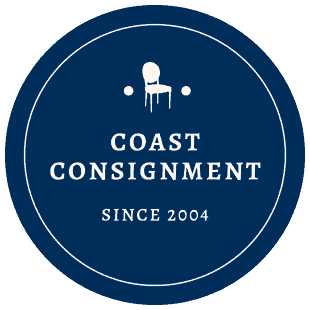Factors in Determining Value of Used Furniture and Home Goods
May 9, 2023
Factors Affecting Value

Oftentimes we find many people trying to research the value of their items online and vastly overestimating the value of their goods. I get this weekly with people seeing that an item is listed for a very high value on 1stDibs.com for example.
One of our owners, Tina, is a Professional Appraiser Certified by the Canadian Personal Property Appraiser’s Group.
Tina prepares 90% of our consignment appraisals as well as offers professional appraisals for insurance, estate/probate, tax and dissolution purposes.
When appraising an item, over a dozen variables spin through Tina’s head as she looks at an item before even beginning to research a piece.
These factors include but are not limited to:
- Style
- Size
- Weight
- Physical Condition
- Colour
- Materials Used
- Where is it located?
- Brand Name
- Age
- Rarity/scarcity
- Functional/technical obsolescence
- Current market conditions
- Current economic conditions
- Shipping
- Quality

There are many sites that list beautiful furniture and objets d’art such as 1stDibs.com, Chairish and Etsy but what you are seeing is only the listing price. Not what an item actually sold for and in this business, negotiation and “deal making” is key. Many of those sites have an “offer” button which allows a potential purchaser to make an offer on an item so you never see the actual sold value which is a much better indicator of price when valuing an item as anyone can list a piece for whatever they want regardless of whether it sells of not.
In addition, many of these pieces are located in cities that have a much larger population than Vancouver where demand is higher and there is a larger market available and a larger selection of architectural types and shipping costs are not as expensive.

When researching an item, Tina does look at comparable listings but we also utilize paid subscription sites such as Terapeak.com and artprice.com that give us actual selling prices and the dates items were sold. Comparable sales in last 3-6 months are the best indicator of value, not listed price.
So many people speak to having an item “custom made”. Custom made does noy translate into more money. When an item is “custom made” it is often been tailored to a very specific taste, space and size and most likely will be a harder sale and worth only 10-20% of what someone actually paid for it. Also, selecting the upholstery you want for a sofa at a furniture store does not mean custom made. Custom made is a much more specific thing than just selecting the finish you want on a piece of furniture.
Size and weight are also huge factors. The larger and heavier a piece of furniture, the more difficult it is to sell due to moving and shipping costs and that the homes or apartments that can accommodate the size and weight may more limited. This is a big factor in value.
Our local market and economic conditions also weigh heavily on a value. Vancouver in the grand geographic scheme is actually a pretty small city population wise and our market is not nearly as strong as markets in Toronto, Montreal, LA and NYC and many other larger US cities. You may think that your item could sell to another City but the costs and logistics of shipping these days is extremely expensive and can cost double to triple the retail price of the item that is being sold. In addition, many special items were not made in North American or Mexico meaning there are also subject to duties and taxes which complicates and increases the cost of buying an item and shipping it even more.
When shipping is “included” when you buy from many big box retailers for new items, rest assured, that shipping cost is hidden in the cost of the item you are buying.
Physical condition is key to maintain value. If an items has damage, stains, rips, tears, fading, chips, missing veneer, new parts etc, this can strip 90-100% of value away. When preparing an item for re-sale, it is imperative that you first clean, polish, vacuum and dust an item to show in it’s best condition. Many damaged items are not saleable at all especially china and crystal.

Of course, styles and trends are another huge factor. Quite simply, if there is no current demand for a style of furniture, the furniture does not have any re-sale value despite it’s quality and how much it may have originally cost.
When selling used goods, the best attitude to have is to be realistic with your expected selling price. Don’t overprice an item because of pride or perceived sentimental value. Recognize that the item is used and that there are billions of items on earth available to purchase so getting some money for your used goods is better than nothing. Oftentimes, the more realistic you are about selling used goods, the better the selling experience.

If you have questions about valuations and appraisals, please don’t hesitate to email [email protected]

